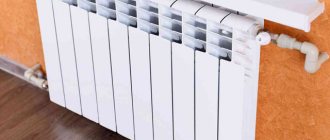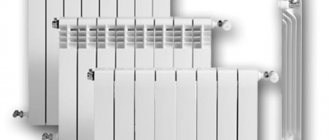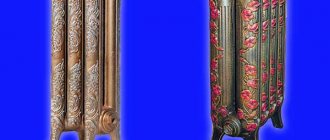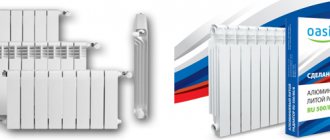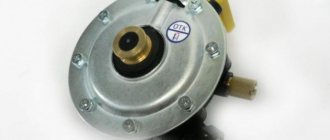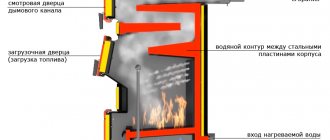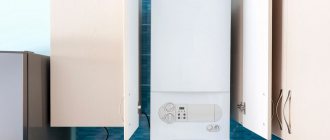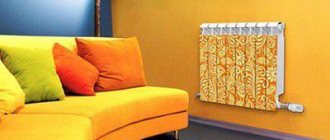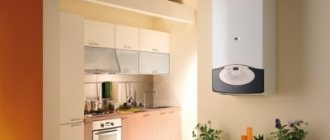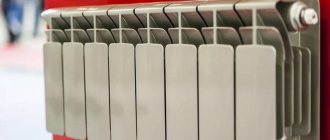| Place | Name | Characteristics in the rating |
| The best manufacturers of aluminum and bimetallic heating radiators |
| 1 | Global | The most famous brand of heating radiators |
| 2 | Rifar | The best Russian manufacturer |
| 3 | Royal Thermo | The best price in the segment of aluminum and bimetallic heating radiators |
| 4 | Sira | High quality and productivity |
| 5 | "Thermal" | Optimal price/performance ratio in a range of products |
| The best manufacturers of metal heating radiators |
| 1 | Buderus | The oldest manufacturer of metal heating radiators |
| 2 | Kermi | Wide range of products. High nominal quality |
| 3 | Purmo | Manufacturer of radiators ideally suited for use in domestic climatic conditions |
| The best manufacturers of cast iron heating radiators |
| 1 | Viadrus | The best manufacturer of cast iron radiators of classic and modern type |
| 2 | Könner | The cheapest products in the cast iron radiator segment |
Similar ratings:
- 10 best brands of bimetallic radiators
Heating radiators are the most important part of residential communications, as they serve to enhance heat transfer from pipes during the winter heating season. Not so long ago, the main production material for radiators was cast iron, but in modern realities, heating systems began to require lighter and more efficient elements. So, gradually, first steel batteries (protected from the harmful effects of water), and then bimetallic and aluminum batteries began to appear in everyday use.
Current market conditions have allowed more than a hundred manufacturers of heating radiators to reach the masses, but only 10-20% of them have managed to gain a foothold in the rank of leaders. The majority of consumers know first-hand the key indicators of batteries, paying attention to heat transfer rates, mounting and design parameters. Based on the experience of experts and reviews of real users, we have compiled a rating of the best manufacturers of heating radiators, worthy of trust and close attention to their products.
Variety of heating equipment from Russian manufacturers
Equipment reliability is not an idle issue in a country where it is cold for more than six months, and the heating season lasts almost as long. For a long time, the emphasis was on cast iron batteries, then they were replaced by lighter bimetallic models of imported production. Almost simultaneously, proposals from other materials appeared, including aluminum and copper.
With the advent of thermal equipment with similar products on the market, Russian manufacturers had to expand the range of products, mastering the production of bimetallic and aluminum or “semi-bimetal” radiators, such as Thermo rus 500 80 (12 sections). All models are classified by type of material:
- steel (base) and aluminum (outer shell);
- copper and aluminum.
Radiators are made from different types of metal
The domestic production of modern heating equipment is developing; in catalogs and specialized stores you can see all types of heating equipment:
- floor;
- wall;
- intra-field.
According to the type of construction, solid (tubular) ones are produced in Russia, such as Monolit 350 100, and sectional models that can be extended in length. The most popular are STOUT Space 350 with 12 sections.
No less popular are the sectional models RBS 500 (bimetallic radiator BM from JSC SANTEKHPROM) and their domestic competitors - GLOBAL batteries. Products made from a steel or copper tube in an aluminum casing are distinguished by excellent thermal output; they are more aesthetically pleasing and practical than their obsolete cast iron counterparts, which had no alternative half a century ago.
However, design options that imitate ancient cast iron “accordions” are also produced by Russian enterprises. Most often these are floor-standing retro radiators with legs from Global, which are in no way inferior to imported models - the soldered design is impressive. They can be repainted, unlike some foreign-made cast iron batteries.
It is also pleasant to note that in the catalogs you can find well-equipped:
- vertical and horizontal models;
- in-floor convectors and built-in units;
- heated towel rails and design radiators, made in a single key.
Bimetal radiators are connected in different ways
It is also easy to find more expensive models on sale, such as Ventil 200 and Base 500 - 100, with different types of connection to the system. Available with side, diagonal and bottom (saddle) connection to central (and autonomous) heating pipes.
The best manufacturers of cast iron heating radiators
Cast iron retains heat for a long time, so heating becomes efficient. But it is more difficult to quickly lower the temperature with such batteries. The advantage of cast iron is its service life of up to 50 years, but its serious disadvantage is its heavy weight. They need to be securely attached to the wall. The designs of such products are varied. For those who love the classics and want to make repairs once in a lifetime, choose heating elements from this category of manufacturers in the rating.
Demir Dokum
Rating: 4.9
The first place among manufacturers of cast iron radiators is occupied by the Turkish company Demir Dokum. The company has been dealing with heating systems for about 60 years and has accumulated solid experience. The company offers several options for cast iron batteries in a modern style, completely different from the old radiators from the USSR. Radiators are pressurized at the factory with a pressure of 15 bar and are designed for continuous operation at 10 bar. The depth of most models is 250 mm, but there are also narrower 100 mm options, which customers like in reviews.
Our experts ranked the manufacturer because of the interesting design of some of its lines. For example, Nostalgia is produced in a retro style shape, but is equipped with a molded pattern (leaves, weaves). The Tower series features clean lines and flared legs reminiscent of a tower. Historic are minted for painting. All this provides ample opportunities not only to create efficient heating, but also allows you to decorate the premises.
Advantages
- modern look;
- emit heat for a long time even after the boiler is turned off;
- compact design;
- power when heating the coolant 70º C - 124 W;
- various painting options.
Flaws
- it is difficult to get dust out of the jumpers;
- warranty only 2 years;
- the weight of 20 kg complicates transportation and installation.
Advantages and disadvantages of domestic bimetal radiators
Bimetal has increased heat transfer. The only weak point of bimetallic models is the junction of steel and aluminum, where they are connected to central heating pipes.
Sectional models are good because they can be extended to the required length
Emergency situations happen extremely rarely, but if there is a high probability of strong water hammer, it is better to take one-piece models, not sectional ones. It is better to entrust the installation of new heating blocks to specialists.
When properly connected, Russian batteries made of 2 types of metal are practically free of disadvantages:
- are characterized by high strength, reliability and durability;
- have maximum efficiency;
- practically eliminate the possibility of leaks in the housing even when increasing the number of sections;
- The design is not inferior to the best imported brands; rounded ribs guarantee safety even in children's rooms);
- they are designed for high operating pressure (up to 20 atm);
- steel ducts are equipped with enhanced anti-corrosion protection;
- adapted for coolants of any quality;
- the catalogs present products of different colors; if you wish, you can contact the manufacturer and order a series of the required shade of heat-resistant enamel to suit your interior;
- many models are equipped with a thermostat and a flow control system to reduce the temperature of the batteries when it warms up (in its absence, it is possible to install it at the junction with the pipes);
- radiators are presented in a wide range of dimensional format (length, width and depth) and number of sections (different from the standard of 12 segments);
- high compatibility with pipes of any heating system, thanks to a wide range of couplings, fittings and adapters;
- price tags for domestic models are significantly lower than those of imported bimetallic analogues.
Like any product, bimetal radiators have certain disadvantages, which are important to know about before making a purchase.
- The batteries have a small diameter of pipes with a similar lumen width, where dirt accumulates over time (the reason for clogging and reducing the efficiency of the system). The problem can be solved by cleaning the radiators. Prevention - installing a filter.
- If the coolant is of poor quality, the service life will be reduced.
- The different coefficient of expansion of steel and aluminum when heated quickly causes a characteristic cracking sound at the joints, but you can get used to it.
- The cost of radiators made of steel and aluminum is higher than cast iron, but this is not a reason to refuse the purchase.
Dirt may accumulate over time at the junctions of pipes and batteries.
How to calculate the required power?
The main thing you need to know before installing a radiator is how much power is required to heat the room. It is advisable to calculate it as accurately as possible so that you don’t have to freeze, but also so that it doesn’t get too hot. It is believed that heating a square meter requires from 100 to 120 W of power (depending on the area, but without taking into account extreme conditions, for example, in the Far North). If the windows in the room are equipped with energy-saving thermal package, the power can be reduced by 15%.
If the coolant temperature is below 70 °C, you need to add 5-15% depending on how much lower it is. If the room is corner, you should add 10%. There are other factors that need to be taken into account, if they are clearly expressed: the total area of all rooms, because they influence each other, how insulated the walls are, and the like - only a simplified version of the calculation will be presented here.
If the area of the room is 18 square meters, it is located in the middle zone and frosts in winter can be quite severe, while it is corner and has ordinary windows, then the calculation will be as follows: for the base figure we take 120 W, add 10% and get 132, and then multiplied by the area comes out to 2376. This is exactly what the total radiator power should be. Now it should be divided by the power of the section. If it is 150 W, then you need to purchase 16 sections.
What to look for when choosing a radiator for your home
When choosing a radiator, you need to take into account not only the type of heating device itself, but also the thermal power indicators and the number of links. The level of heat transfer directly depends on the characteristics of the material used in production:
- cast iron models – 80-150 W (one section);
- steel radiators – 450-5700 W (entire battery);
- aluminum structures – 190 W (one section);
- bimetallic batteries – 200 W (one section).
The power indicators of the device are indicated in the technical specifications, but the optimal temperature regime of the coolant is, as a rule, 70°C.
The design features of the radiator are important. The battery device can be sectional or panel. The first option is more universal, which allows you to select the length of the device (number of sections) in accordance with the required power and heat losses. To connect the sections, special nipples are used, and a gasket is installed between the elements.
The connection method differs between cross connection (diagonal), as well as side and bottom circuits. The choice of connection option depends on the size of the heated area, as well as the level of thermal energy consumption. The most ineffective is a single-point connection, and the most promising is the diagonal method.
Modern models from domestic and foreign manufacturers have many undeniable advantages, including a special coating, resistance to corrosive changes and the presence of advanced functionality, including air ozonation and thermoregulation according to user-specified parameters.
back to menu ↑
What is the difference between heating made of steel and aluminum produced in Russia?
Bimetallic radiators from a Russian manufacturer demonstrate high reliability in extreme conditions - during system water hammer (pressure surges) and water contamination. The internal coating of the steel base protects heating equipment well from rust.
Important! Although the manufacturer’s documents indicate “stainless steel,” over time, the internal protection loses its resistance to corrosive processes. They are inevitable, especially after draining the water from the pipes in the summer.
In Russian realities, the most attractive bimetallic radiators from foreign brands often cause disappointment - due to their inability to cope with extreme conditions. In addition, our products have sufficient thickness of pipes and housing, so heating systems can withstand periods of severe frosts well.
Russian manufacturing plants have long moved away from the old production system and switched to new technologies that guarantee up to 20-30 years of flawless operation. Not only their functionality is encouraging, but also their excellent design - they fit perfectly into various interiors (homes, offices, shops).
Radiators from Russian manufacturers can be used for several decades
Russian batteries are made of a steel frame in an aluminum case, onto which thermal enamel is applied. It has increased resistance to scratches and mechanical damage. If desired, the batteries can be repainted in a different color or re-opened to eliminate defects, but you need the same (high temperature resistant) paint for metal.
Experts also recommend paying attention to domestic models from RIFAR and MONOLIT. They are several times cheaper than the Italian STYLE PLUS 500 and the German TENRAD 500. Russian equipment remains optimal for heating all types of premises, including city apartments and the private sector, trading floors and office centers.
On the market you can find low-quality Chinese counterfeits of branded products:
- pipes and fittings for battery installation;
- bimetallic (and other) models;
- heating radiators;
- heated towel rails,
- convectors;
- design radiators.
Therefore, it is necessary to purchase heating equipment from branded stores and retail outlets offering certified products.
ROMMER
The Russian manufacturer is known for producing products for heating systems in China. The company located here due to the freedom to conduct business. However, this did not prevent the ROMMER brand from receiving the attention of the domestic audience and occupying good places in the ranking.
Reasons for the demand for nonsense products:
- in production, aluminum alloy is used that complies with GOST 1583-93 and EN 1706 - these are important quality standards;
- radiators are produced using equipment from well-known European brands: Marconi melting furnaces (Italy), Wagner painting stations (Germany), Sir battery processing lines (Italy);
- The batteries are compact in design, treated internally with the anti-corrosion compound Corprotectione, and have an all-steel Stieelbimetal collector.
The cost of heating devices is kept at an adequate level.
Features of domestically produced bimetallic products
The quality of domestic products is determined by the introduction of publicly available technologies, patented know-how from world brands and the development of bimetallic heating radiators by domestic specialists. One of the advantages is the protection of the internal surface, like products like Rifar base ventil 350.
The need for such equipment improvement is associated with the low quality of the coolant supplied to central city systems.
Helpful advice! While Russian standards for water circulating through central heating pipes will be far from European standards, it is better to rely on domestic space heating units.
Russian bimetallic products differ:
- high strength;
- adaptability to blowing and cleaning from rust and dirt;
- the ability to connect in different ways;
- adaptation of the battery format to the window sill of most panel houses;
- the possibility of using antifreeze (non-freezing coolant in a closed circuit of private houses).
Such radiators are suitable for installation in residential, office and any other premises
The characteristics give the right to assert that domestic products are no worse than imported analogues, and remain more attractive in cost.
